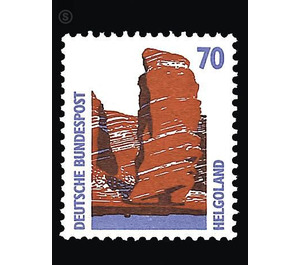Postage stamps: Places of interest - Germany / Federal Republic of Germany 1990 - 70 Pfennig
Theme: Art & Culture
| Country | Germany / Federal Republic of Germany |
| Issue Date | 1990 |
| Face Value | 70.00 |
| Color | brown white |
| Perforation | K 14 |
| Printing Type | indirect 2-color letterpress |
| Stamp Type | Postage stamp |
| Item Type | Stamp |
| Chronological Issue Number | 1342 |
| Chronological Chapter | GER-BRD |
| SID | 859517 |
| In 44 Wishlists | |
Heligoland was created millions of years ago in Triassic and Tertiary. The island was once a multiple of its present size and consisted of the Buntsandsteinfelsen, the Witten cliff (chalk cliffs) and the dune. In 1711, the Witte cliff fell under a huge storm surge, in 1721 broke the connecting dam between the island (rock) and dune. On the west side of the island, Blanke Hans continued his work of destruction. For decades, protective walls have protected the island from the sea. Stone and Bronze Age finds bear witness to the settlement of Heligoland long before the birth of Christ. In its eventful history, belonging to both Denmark and Schleswig-Gottorp, the island fell back to Denmark in 1714. In 1807 it was annexed by Britain. At the time of the Continental Blockade, the island was the most important trading center in northern Europe. After the golden years of the continental blockade, Helgoland went downhill economically. In search of new sources of income Jacob Andresen Siemens founded 1826 the seaside resort of Heligoland, which flourished in the following decades. Heinrich Hoffmann von Fallersleben wrote in 1841 on the island the song of the Germans, which became national anthem in 1922. For the science, the island became significant through the founding of the Marine Biological Research Institute and the Ornithological Institute. On August 10, 1890 Helgoland was handed over to the German Reich in exchange for colonial rights in the former German East Africa. During the two world wars Heligoland was naval fortress. This meant a two-year long evacuation for the population and resulted in the destruction of Heligoland during the Second World War. After long efforts Helgoland was released on 1 March 1952 for repopulation. Then came the reconstruction and the return of the ancestral population with the support of the entire German people. (Text: Municipality of Helgoland, The Mayor)


